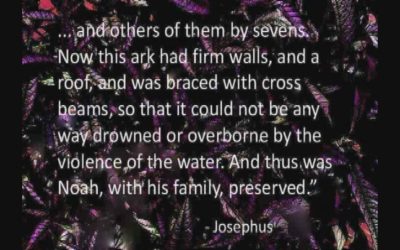When the King James translation was produced in 1611, nothing was known of geology or cosmology. Anthropology was an unknown science, and the history of the ancient Near East has come to light only since the late 1800s. As a result the translators of the “Authorized Version” labored in a vacuum of mitigating evidence that would have helped them immensely. The result is that Genesis 1-11 in the KJV virtually is stuck in the 17th century. A Revised King James Version takes into account the...
Creation Genesis and Origins – Putting It All Together
Approximately 3,000 years of biblical history lies between the time of Adam’s introduction near Eridu in southern Mesopotamia about 7,000 years ago until Sumer is destroyed around 4,000 years ago and Abraham departs for Canaan. The historicity of Genesis 2-11 is corroborated to a degree never before seen by the history of the ancient Near East only recovered within the last 200 years. Bible commentators for the most part have not departed from traditional beliefs established many centuries...
Creation Genesis and Origins – Searching for the Tower
Early explorers ventured into the land of “Arabian Nights” seeking adventure, fame, prestige, honor, glory, knowledge, trinkets, and a certain elusive tower. The 20th century brought forth a new breed of explorer, as much bent on returning souvenirs to their homeland as ascertaining the intricacies of a distant, ancient civilization. Expecting to find an ancient structure, they looked for signs of sheer antiquity. Such was not to be seen, however, Assyrian king Sennacherib sacked Babylon...
Creation Genesis and Origins – Making Sense of Babel
The Tower of Babel was constructed during the timeframe that towers were being built all over Mesopotamia and Persia. Mud brick platforms constructed initially to survive spring floods grew over time to become temples to honor and worship whatever pagan god protected their city. The Tower of Babel was one among a number of ziggurats constructed in cities throughout the region. Only the later generations of Shem, named in the eleventh chapter of Genesis, found themselves living in Babylon ruled...
Creation Genesis and Origins – Tower of Babel Less Confusing
After the flood, platforms constructed in the Mesopotamian cities began to grow and take on religious connotations. Mud brick mounds that had originally been constructed to survive floods became ziggurats adorned with temples of worship, the dwelling places of the gods, and temples were constructed dedicated to whatever god was protecting each individual city. The Atlas of Mesopotamia located over thirty ziggurats and temple mounds in Mesopotamia, including some in Persia. These were massive,...
Creation, Genesis and Origins Out and About
Noah’s family remained concentrated near the mountainous region where the ark landed and where Noah planted his vineyard. According to Jubilees, Noah’s three sons divided themselves into three different cities named for their wives. Their families grew over 350 years until the death of Noah. After Noah died about 2550 BC his sons, grandsons and great grandsons and their families venture forth to live in the lands and territories to which they were assigned. Noah may have seen the warlike...
Creation, Genesis and Origins Locating the Ark
Commonalities between Mesopotamian texts and the Genesis narrative underscore its’ historicity. It was Ziusudra, hero of the flood, who “kept the name of mankind alive” according to the Sumerian composition. His name translates “life of prolonged or distant days.” He is a king in the texts and in the Sumerian King List. Although Genesis states Noah lived 950 years, Jewish historian Josephus used the word “governed” which places him in the category of “king” and supports the understanding that...
Creation, Genesis and Origins End of the Voyage
Where did the ark come to rest? The landing site has been a subject of dispute for centuries. Ancient reports of ark sightings abounded from 400 BC to the 13th century AD. Modern reports, some suspicious, have occurred up until today. Over the centuries, eight different landing places have been named, however, most of these legendary resting sites center around three locations: Mount Ararat (Agri Dagh) in Turkey, northeast of Lake Van; Mount Cudi (Judi Dagh or Jebel Judi) southwest of Lake Van...
Creation, Genesis and Origins The Mesopotamian Flood
Evidence for the great flood of Noah’s day from historical and archaeological sources is examined and compared to the Genesis record. Who was the target of the flood? Who survived? The judgment of the Mesopotamian flood at around 2900 BC was upon those who were accountable. Under the influence of the nearby Sumerians, the Adamic race, the covenant race became corrupt. Divine grace could no longer sustain them. The sword of the Spirit came by way of a purifying flood.
Creation, Genesis and Origins Angels and Giants
The "sons of God” in Genesis 6:2, who are they? Some contend these are angels, perhaps fallen angels. But is that the case here? The Hebrew phrase in this passage, and elsewhere in the Old Testament, can refer to angels, but the same term also describes humans who lived their lives in service to God. How should it be interpreted here? Were disenfranchised angels frolicking with the human race?
Creation, Genesis and Origins Adam and Associates
Adam and his generations fit into a historical time and place. The time is approximately seven thousand years ago in the region the Hebrews called “Shinar” in the Old Testament that we know as Sumer, southern Mesopotamia, present-day Iraq. A land associated with the Sumerians who lived in that region for roughly 2,000 years, biblically corresponding approximately to the time from Adam to Abraham – a family of non-Sumerians that have been called Akkadians in history books.
Creation, Genesis and Origins Adams Family
Looking at the subject of a historical Adam we have to face a reality. Either Adam was a real-life, flesh and blood, God-fearing human being, or he wasn’t. There is no intermediate position. We either have Adam wearing his fig leaf, or we have Adam who was only a figment. The issue can be couched in theological terms, but there is no escaping a fundamental fact of life, or non-life. Adam either existed in the flesh, or he didn’t.
Creation, Genesis and Origins -Legend of Adapa
Several fragments of the "Legend of Adapa" were taken from the Library of Assyrian King Ashurbanipal at Nineveh. One also was found in the Egyptian archives of Amenophis III and IV of the fourteenth century BC. All but one is written in Akkadian. According to the legend, Ea, the god of wisdom, created Adapa an exemplary man, endowed with "superhuman wisdom," but not eternal life although it was extended to him. Many commonalities suggest this story was based upon their legendary forefather,...
Creation, Genesis and Origins Leaving the Garden
Adam has a place in redemptive history. As God's ambassador, he was the first person who had access to God's kingdom which required simple obedience. We can only guess at what Adam might have done had he remained obedient. Created in the “image of God,” Adam was a representative whose purpose in all probability was to bring the human-populated world into a similar relationship, but being human himself, he wasn’t up to the task. The theme of an evil serpent and a “sacred tree” endured in...
Creation, Genesis and Origins The Sumerian King List
The Sumerian King Lists are among the curiosities that have never been explored, explained or understood. These lists were found in some of the oldest cities in Mesopotamia and contain the names of kings who reputedly reigned over the entire region before the flood and continue with kings who reigned over cities restored and founded after the flood. Of interest is that the king lists can be correlated to some of Adam’s descendants listed in Genesis Five up to and including Noah (“Ziusudra” in...













